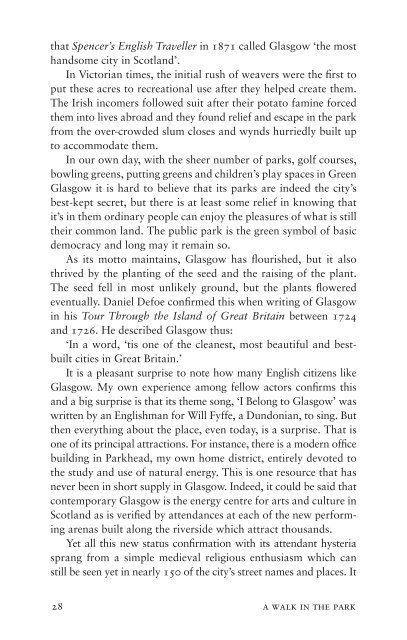A Walk in the Park by John Cairney sampler
A wander through twelve of Glasgow’s finest parks, and through the mind of a treasured Glasgow resident, John Cairney. Cairney’s exploration of his home city’s dear green places ranges from Tollcross Park in the east, to the Botanic Gardens, pride of the West End, and even right out to Hogganfield Loch in the city’s furthest reaches. Written with a deep love of the city, A Walk in the Park takes us on a journey into Glasgow’s past as well as through its outdoor spaces. Cairney traces his city’s history back a millennium to its founding by that great wanderer, St Mungo. Through the stories of its parks Glasgow comes to life, a post-industrial city with an unmatched individuality, a thriving cultural scene, and a lot to look forward to.
A wander through twelve of Glasgow’s finest parks, and through the mind of a treasured Glasgow resident, John Cairney. Cairney’s exploration of his home city’s dear green places ranges from Tollcross Park in the east, to the Botanic Gardens, pride of the West End, and even right out to Hogganfield Loch in the city’s furthest reaches.
Written with a deep love of the city, A Walk in the Park takes us on a journey into Glasgow’s past as well as through its outdoor spaces. Cairney traces his city’s history back a millennium to its founding by that great wanderer, St Mungo. Through the stories of its parks Glasgow comes to life, a post-industrial city with an unmatched individuality, a thriving cultural scene, and a lot to look forward to.
Create successful ePaper yourself
Turn your PDF publications into a flip-book with our unique Google optimized e-Paper software.
that Spencer’s English Traveller <strong>in</strong> 1871 called Glasgow ‘<strong>the</strong> most<br />
handsome city <strong>in</strong> Scotland’.<br />
In Victorian times, <strong>the</strong> <strong>in</strong>itial rush of weavers were <strong>the</strong> first to<br />
put <strong>the</strong>se acres to recreational use after <strong>the</strong>y helped create <strong>the</strong>m.<br />
The Irish <strong>in</strong>comers followed suit after <strong>the</strong>ir potato fam<strong>in</strong>e forced<br />
<strong>the</strong>m <strong>in</strong>to lives abroad and <strong>the</strong>y found relief and escape <strong>in</strong> <strong>the</strong> park<br />
from <strong>the</strong> over-crowded slum closes and wynds hurriedly built up<br />
to accommodate <strong>the</strong>m.<br />
In our own day, with <strong>the</strong> sheer number of parks, golf courses,<br />
bowl<strong>in</strong>g greens, putt<strong>in</strong>g greens and children’s play spaces <strong>in</strong> Green<br />
Glasgow it is hard to believe that its parks are <strong>in</strong>deed <strong>the</strong> city’s<br />
best-kept secret, but <strong>the</strong>re is at least some relief <strong>in</strong> know<strong>in</strong>g that<br />
it’s <strong>in</strong> <strong>the</strong>m ord<strong>in</strong>ary people can enjoy <strong>the</strong> pleasures of what is still<br />
<strong>the</strong>ir common land. The public park is <strong>the</strong> green symbol of basic<br />
democracy and long may it rema<strong>in</strong> so.<br />
As its motto ma<strong>in</strong>ta<strong>in</strong>s, Glasgow has flourished, but it also<br />
thrived <strong>by</strong> <strong>the</strong> plant<strong>in</strong>g of <strong>the</strong> seed and <strong>the</strong> rais<strong>in</strong>g of <strong>the</strong> plant.<br />
The seed fell <strong>in</strong> most unlikely ground, but <strong>the</strong> plants flowered<br />
eventually. Daniel Defoe confirmed this when writ<strong>in</strong>g of Glasgow<br />
<strong>in</strong> his Tour Through <strong>the</strong> Island of Great Brita<strong>in</strong> between 1724<br />
and 1726. He described Glasgow thus:<br />
‘In a word, ‘tis one of <strong>the</strong> cleanest, most beautiful and bestbuilt<br />
cities <strong>in</strong> Great Brita<strong>in</strong>.’<br />
It is a pleasant surprise to note how many English citizens like<br />
Glasgow. My own experience among fellow actors confirms this<br />
and a big surprise is that its <strong>the</strong>me song, ‘I Belong to Glasgow’ was<br />
written <strong>by</strong> an Englishman for Will Fyffe, a Dundonian, to s<strong>in</strong>g. But<br />
<strong>the</strong>n everyth<strong>in</strong>g about <strong>the</strong> place, even today, is a surprise. That is<br />
one of its pr<strong>in</strong>cipal attractions. For <strong>in</strong>stance, <strong>the</strong>re is a modern office<br />
build<strong>in</strong>g <strong>in</strong> <strong>Park</strong>head, my own home district, entirely devoted to<br />
<strong>the</strong> study and use of natural energy. This is one resource that has<br />
never been <strong>in</strong> short supply <strong>in</strong> Glasgow. Indeed, it could be said that<br />
contemporary Glasgow is <strong>the</strong> energy centre for arts and culture <strong>in</strong><br />
Scotland as is verified <strong>by</strong> attendances at each of <strong>the</strong> new perform<strong>in</strong>g<br />
arenas built along <strong>the</strong> riverside which attract thousands.<br />
Yet all this new status confirmation with its attendant hysteria<br />
sprang from a simple medieval religious enthusiasm which can<br />
still be seen yet <strong>in</strong> nearly 150 of <strong>the</strong> city’s street names and places. It<br />
28 a walk <strong>in</strong> <strong>the</strong> park


















